前景实用英语二unit3教案
前景实用英语(二)-unit6教案

前景实⽤英语(⼆)-unit6教案三亚航空旅游职业学院教案编号Unit 6 Greening the World Begins at Home Teaching aims:In this unit, students are supposed toMaster the basic language and skills to remember wordsUnderstand the main idea of Text A, and master the useful sentence structures and words and expressions; Know how to use sentence stress;To learn Non-finite Verb;To know how to write “Business Letter”.Teaching procedures:I Listening and Speaking (2Period)II Text A & text-related exercises (2Period)III Grammar Review and Practical Writing (2Period)IV WorkbookPart A Lead inTask 1 Study the pictures and discuss the questions below in small groups. Use the words given below if necessary.1.What can we benefit from the equipment in the first picture?Cues: solar energy, renewable, green energy, water heater, electricity bill2.Do you know what the house in the second picture is called? What is specialabout it?Cues: passive house, energy-efficient, solar panel, roof3.What are the advantages of the U-shaped lamps in the third picture?Cues: saving, cut on the use of electricityTask 2 Listen to the following short dialogues and fill in the blanks.Task 3 Discuss the following questions.1. What do you think is green living?Cues: healthy, environment-friendly, lifestyle.2. What does your family do to cut energy use?Cues: water, electricity, transport, travelPart B Language points1. green v. to make greene.g. The company is making efforts to green its products.公司正竭尽全⼒使产品更环保。
前景实用英语(二)-unit3教案

前景实用英语(二)-unit3教案三亚航空旅游职业学院教案编号Unit 3 Knowledge and SkillsTeaching aims:In this unit, students are supposed to▪know how to talk about learning in daily life;▪master the basic language to express reassuring and persuading;▪understand the main idea of Text A, and master the useful sentence structures and words and expressions;▪master the phonetic skill: assimilation;▪know substantive clause;▪know how to write “A Postcard”.Teaching procedures:I Listening and Speaking (2Period)II Text A & text-related exercises (2Period)III Workbook & text-related exercises (2Period)IV Grammar Review and Practical Writing (2Period)Part A Lead inTask 1 Study the pictures and discuss the questions below in small groups. Use the words given below if necessary.1.What are the people in the first picture doing?Cues: basketball, training, trainer, trainee2.How do you understand the words in the second picture? Do you knowthe Chinese for it ?Cues: the more ... the better ..., practice, learn, well3.What is “stage fright”?Cues: fear, anxiety, public, audience, sweaty handsTask 2 Listen to the following short dialogues and fill in the blanks.Task 3 Discuss the following questions.1. How can we learn a skill?Cues: knowledge, practice, familiar, second nature2.Have you ever had any experience of stage fright? If yes, please share onewith the class.Cues: knowledge, practice, familiar, second naturePart B Text ALearning Knowledge and Skill: PracticeLanguage points:Leakya. having holes or cracks that allow liquid or gas to escapee.g. Water came from the leaky roof.水从屋顶漏下来。
新编实用英语综合教程第二册unit3课后练习答案

新编实用英语综合教程第二册unit3课后练习答案新编实用英语综合教程第二册Unit 3课后习题答案P39-11 speak2. where is he3. might be with4. leave a message5. call me6. 667-34527. welcomeP39- 21. Hello , May I speak to Mr. Smith please2.Yes , please , tell hime to call the director's office , the number is 864-35093. It would be best if he cold call this afternoon , at about 2o'clock4. thanks a lotP39-31. Hello2. I am sorry , but he is not in at the moment , would you like to leave a message ?3. I 'll tell her as soon as he is back4. You're welcome .P40-31. a telephone message2. a memo3. phone4. at home5. personal6. skills7. a message8. expect9. who called10. what was the message11. friends and family12. questions13. when they called14. the person calling15. reach himP41-41- b 2- dP43-11. Because people stopped talking face to face to one another2. Because his friends was busy talking on the phone , completely forgetting his present3. Because they can be used anywhere and anytime4. Without seeing or talking to one another and with voice mail , we can conduct entire poeple losetheir inimacy of interaction .5. People lose their intimacy of interaction6. He thinks it's great , but worries about its unintended consequences .P43-21. disconnected2. set back3. internet4. talking5. reaching6. answer7. contact8. goes up9. phone10. automatedP43-31. the communications revolution2. their cell phones3. electronic voice4. e-mail5. voice mail6. Directory assistance7. greatP44-41. burden2. advances3. lonely4. invisible5. insert6. attendents7. pets8. chain9. preferable10. deposit11. interrupted12. EvidentlyP44-51. Please dial home and tell them I am on the way to the company2. Since then there was never been any setback in production3. I saw him insert the key into the lock4. I suggest that you make a deposit at the bank5. Yesterday Mr.wang checked out from that hotel .P44- 61. The hall was filled with students waiting for the interview .The square of the village was filled with people waching the football match2. We used to grow beautiful rosesPeter used to go to the small town3. Why is it that this conclusion is wrongwhy is it that she can sing better than I4. As I knew him better , I discovered that my first impression of him was right .We got wiser as we get older5. Why use wood when you can use plastic ?why ask me to do it when you can do it yourself ?6. Pretty soon you won't have the burden of cooking breakfast for himpretty soon you won't take the trouble to send her to go to school everymorning .P46-71-T 2- F 3-T 4-T 5- T 6- F 7-T8- T 9-F 10- T 11. T 12- TP47-91. 不管有时是字母与数字混合使用,所有电话号码都是7位数字。
新编实用英语综合教程第二册第三单元
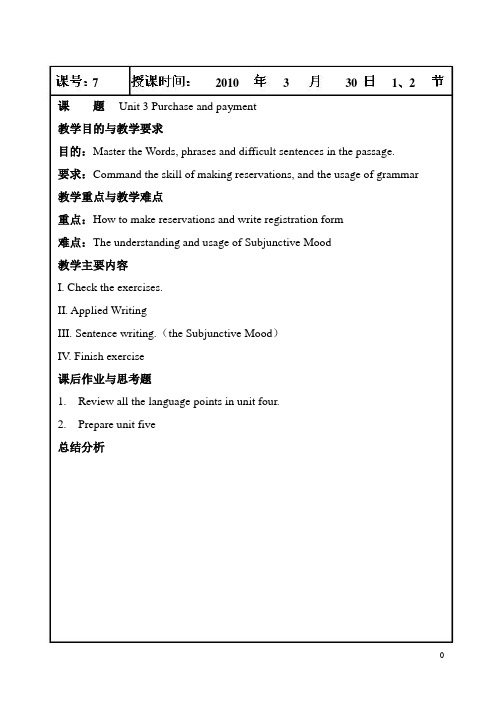
7 2010 3 30 1、2 课题Unit 3 Purchase and payment教学目的与教学要求目的:Master the Words, phrases and difficult sentences in the passage.要求:Command the skill of making reservations, and the usage of grammar 教学重点与教学难点重点:How to make reservations and write registration form难点:The understanding and usage of Subjunctive Mood教学主要内容I. Check the exercises.II. Applied WritingIII. Sentence writing.(the Subjunctive Mood)IV. Finish exercise课后作业与思考题1. Review all the language points in unit four.2. Prepare unit five总结分析教学过程教学环节与时间分配1. My name is Vanessa Saunders.我名叫雯妮莎桑德斯。
2. I have visited China sixteen times since 1978.1978年以来,我已来过中国16次。
3. I have been conducting tradeshows and setting up tradeshow exhibitions for a variety of international clientsa. conduct: vt.引导,经营。
Eg. The headmaster conducted us round the school.校长带引我们在学校里参观了一圈。
新编实用英语综合教程二Unit-3-Communication-by-Phone专业课件PPT

● Refer to the Data Bank in the Workbook for relevant expressions.
Back
7
Studying Telephone Messages
Study and Imitate 3 Taking or leaving a telephone message is part of a secretary’s job. Now let’s
Bill: I’m sorry. Lady: That’s all right.
Back
11
Putting Language to Use
Speak and Complete
5 Imagine you are calling Judy. Complete the following conversation with her by filling in the blanks.
I speak You: Hi, Judy. It’s Mike. May 1 ______________ to Ken? Judy: I’m sorry, Mike, but Ken’s not here now. You: He isn’t? 2 ___W_h_e_r_e_i_s_h_e___? Judy: He’s at a movie. You: A movie? Who’s he with? Judy: Well, uh, I think he 3 ______________ Eva.
Putting Language to Use
Speak and Complete
Speak and Translate
Speak and Communicate
实用英语综合教程第二册教案
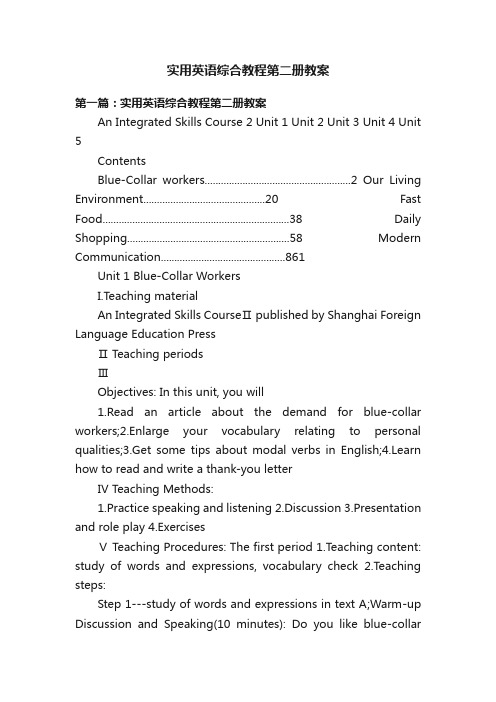
实用英语综合教程第二册教案第一篇:实用英语综合教程第二册教案An Integrated Skills Course 2 Unit 1 Unit 2 Unit 3 Unit 4 Unit 5ContentsBlue-Collar workers......................................................2 Our Living Environment.............................................20 Fast Food.....................................................................38 Daily Shopping............................................................58 Modern Communication. (861)Unit 1 Blue-Collar WorkersI.Teaching materialAn Integrated Skills CourseⅡ published by Shanghai Foreign Language Education PressⅡ Teaching periodsⅢObjectives: In this unit, you will1.Read an article about the demand for blue-collar workers;2.Enlarge your vocabulary relating to personal qualities;3.Get some tips about modal verbs in English;4.Learn how to read and write a thank-you letterⅣ Teaching Methods:1.Practice speaking and listening2.Discussion3.Presentation and role play4.ExercisesⅤ Teaching Procedures: The first period 1.Teaching content: study of words and expressions, vocabulary check 2.Teaching steps:Step 1---study of words and expressions in text A;Warm-up Discussion and Speaking(10 minutes): Do you like blue-collarjobs? What is your favorite blue-collar job and why?Hints: I like blue-collar jobs because(1)the demand is huge;(2)you can get professional training and technical knowledge;(3)the salary is goodMy favorite blue-collar job is that of a gardener, because(1)I can work outdoors and enjoy the fresh air;and(2)I can keep fit and get good pay(The students will probably have trouble with English expressions relating to blue-collar jobs.The teacher may allow the students to answer this question in Chinese, and then give the students key terms in English and ask them to express their ideas again in English.)Background Information(5 minutes)Blue-collar workers(TB P2)Different categories of jobs(blue-collar/golden-collar/pink-collar/grey-collar/white-collar)Introduce new words on board:(20 minutes)heartland resident workforcereplacementreplaceshortage manufacturermanufacture remarkable recoveryannualearnings earnpoint togap high-end decline expand certificateprograminvestmentinvest find a way upStep 2—Practice: Vocabulary Check and Oral English(10 minutes)Give students 5 minutes to finish exercises A in Page 9Everyday English 1.If you want to stop someone and ask him/her for directions, what do you usually say to him/her first?(Excuse me.)2.If you don’t quite understand what the person has told you about the directions, what can you do?(Although one can always say “I beg you pardon?” or “Could you say it again?” try not to make the person repeat more than twice.Instead, you may repeat what you’ve already understood and let the person tell you the test.)3.While traveling in a foreign country, what would you bring along to make your travel easier?(A road map.)The second period 1.Teaching content: Discussion and Comprehensive of Text A 2.Teaching steps:Step 1---Warm up(10 minutes)(invite some students to explain the meaning of the difficult sentences of the text A in English or in Chinese, teacher may give them some hints.) Step2---Language Points(25 minutes)1)To many… offer its residen ts: For many people, America’s industrial heartland can’t provide enough work to its residents.too little: not too much, not enough 太少Too much work and too little rest often lead to illness.过量的工作和过少的休息会引起疾病。
前景实用英语教案

3. Do you like T-shirts with words?
Cues: message, simple
2. Call a few groups to report the result of their discussion.
Cues: ideas, taste, imitate
Step Five
New words in Text A
(mainly using the method of explaining)
1. Tell students we will learn the new words and expressions in Text A“Greening the World Begins at Home”.
Step Three
Task2
Listening(mainly training Ss’ listening ability by guiding them how to listen)1. There are two listening dialogues in this task. The students can be allowed to read the dialogues first and try to finish the blanks in the dialogues.
1. Have you had the experience of not knowing what to wear on a certain day?
Cues: occasion, feeling
2. Do movies, advertisements or fashion magazines have any impact on you?
前景实用英语教案
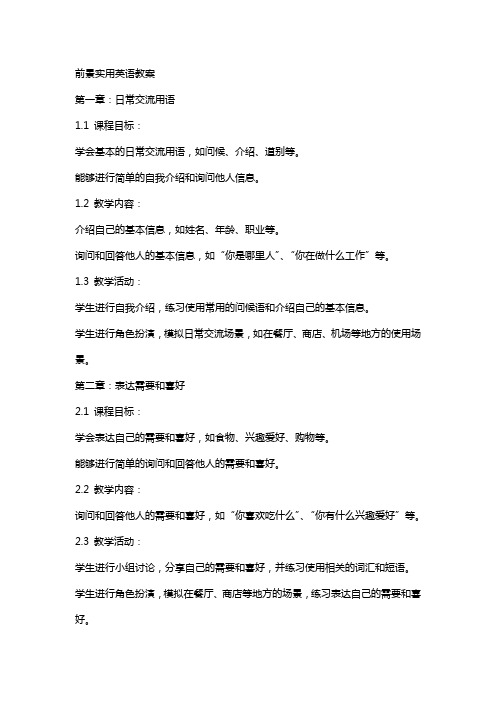
前景实用英语教案第一章:日常交流用语1.1 课程目标:学会基本的日常交流用语,如问候、介绍、道别等。
能够进行简单的自我介绍和询问他人信息。
1.2 教学内容:介绍自己的基本信息,如姓名、年龄、职业等。
询问和回答他人的基本信息,如“你是哪里人”、“你在做什么工作”等。
1.3 教学活动:学生进行自我介绍,练习使用常用的问候语和介绍自己的基本信息。
学生进行角色扮演,模拟日常交流场景,如在餐厅、商店、机场等地方的使用场景。
第二章:表达需要和喜好2.1 课程目标:学会表达自己的需要和喜好,如食物、兴趣爱好、购物等。
能够进行简单的询问和回答他人的需要和喜好。
2.2 教学内容:询问和回答他人的需要和喜好,如“你喜欢吃什么”、“你有什么兴趣爱好”等。
2.3 教学活动:学生进行小组讨论,分享自己的需要和喜好,并练习使用相关的词汇和短语。
学生进行角色扮演,模拟在餐厅、商店等地方的场景,练习表达自己的需要和喜好。
第三章:询问方向和地点3.1 课程目标:学会询问方向和地点,如问路、找到某个地方等。
能够准确地表达自己的位置和方向。
3.2 教学内容:常用的询问方向和地点的词汇和短语,如“请问在哪里”、“怎么走”等。
表达自己的位置和方向,如“我在超市的旁边”、“你往前走,左转”等。
3.3 教学活动:学生进行角色扮演,模拟在街头问路的情景,练习使用相关的词汇和短语。
学生进行小组活动,制作简单的地图,练习表达自己的位置和方向。
第四章:描述人和事物4.1 课程目标:学会描述人和事物的特征和属性,如外貌、性格、喜好等。
能够准确地表达自己的观察和看法。
4.2 教学内容:常用的描述人和事物的词汇和短语,如“高个子”、“善良的”、“喜欢音乐”等。
表达自己的观察和看法,如“我觉得他很聪明”、“她看起来很累”等。
4.3 教学活动:学生进行小组讨论,描述自己或他人的外貌和性格特点,并练习使用相关的词汇和短语。
学生进行角色扮演,模拟在面试或相亲等场合描述自己和对方的特征和属性。
新实用英语视听说教程(第2册)(第二版)课件unit 3

新实用英语视听说教程(第2册)第二版
BACK
Transcript
Sports injuries, falls, and accidents can all lead to almost filling, cap, or other dental emergencies. Here are some temporary first aid measures to hold you until you get professional treatment.
immediately.
Rinse a dislodged tooth in water if it is dirty. Place it in _a__c_u_p_o_f_m__ilk__ and take it to your
dentist.
Rinse your mouth with warm water if you have a toothache. Try using _d_e_n_t_a_l f_lo_s_s_ to remove
新实用英语视听说教程(第2册)第二版
CONTENTS
Teaching Tips
PART Ⅲ Speaking Development
PART Ⅰ Video Comprehension
Topic introduction Cultural Background
Episode 1 How to Handle a Dental Emergency New Words and Expressions
前景实用英语综合教程2

前景实用英语综合教程2前景实用英语综合教程Practical English Comprehensive Course前言:Introduction《前景实用英语综合教程》是一本针对初学者设计的英语教材,旨在帮助学生提高英语听说读写能力。
本教程主要分为听力、口语、阅读和写作四个部分,通过多种练习形式,如对话、听力理解、口语表达、阅读理解和写作练习等,让学生全面掌握实用英语的基本技能。
<Preface> "Practical English Comprehensive Course" is anEnglish textbook designed for beginners, aiming to help students improve their English listening, speaking, reading, and writing skills. This tutorial is mainly divided into four parts: listening, speaking, reading, and writing. Through various exercises such as dialogues, listening comprehension, oral expression, reading comprehension, and writing exercises, students can comprehensively master the basic skills of practical English.第一部分:听力Part 1: Listening听力是语言学习的基础,也是交流的基本技能之一。
通过听力练习,学生能够提高对于英语语音、语调和语速的理解能力,提升听力水平。
本部分主要包括日常对话、新闻、访谈等各种题材的听力材料,学生通过听力理解题考察对于听力材料的理解和把握能力。
前景英语unit 3 教案

P1a.gde e3vooft7e devoted
Unit I
devotee
devotion
大 学 英 语 III 教 案
公共外语部第二教研室
absorbing absorbed absorbent absorption
Step 3: Finish the exercises from task 2 to task 5(25 min)
1. Forward English (Teacher’s Book III) 2. Forward English Viewing, Listening & Speaking 3. College English (Using English Grammar)
( Teacher’s Book III)
Page 5 of 7
Unit I
大 学 英 语 III 教 案
公共外语部第二教研室
教学组织(含每课时课堂教学内容、教学方法、师生互动、时间分配、板书设计等):
备注
Unit 3 Optimism
Periods 5&6
I. Warming – up (10 min) Work in pairs and discuss the following questions: 1) Did you have any unhappy and stressful experiences in your life? 2) How do you stay optimistic after those experiences?
1. Read the guidelines for writing the minutes of a meeting. (10 min) 2. Do the exercise on page 64 and page 65. (15min)
实用大学英语综合教程(基础版)课件 Part 2 Unit 3

W: Sure, please come on.
M: Oh, this will serve my purpose. I will come tomorrow for making a 10. _c_o__n_tr_a_c_t_.
W: All right. You are welcome.
B. Listen to the dialogue again and circle the correct answers.
2. Asking for Information
A. Listen to the dialogue and fill in the blanks with the missing words.
(M=Man,W=Woman)
M: Excuse me. Is Mrs. Miles in? W: Yes, I am Mrs. Miles. May I know your purpose, please?
True False ( )( ) ( )( ) ( )( ) ( )( )
KEY: 1. T 2. F 3. F 4. T
A: I’m calling about the apartment for rent. Is it still available? B: Yes, it is. Do you know where we’re located? A: Yeah. I drove by yesterday and I liked the location. What’s the rent? B: It’s $1000 a month, plus electricity. So you would pay $500 a month. But the parking is free. A: OK. How big is the house? B: It has two bedrooms, one bathroom and is roughly about 820 square feet. A: Is the complex quiet? Can you hear a lot of noise? B: They have a strict policy in the apartment complex concerning noise level. So it stays very quiet after 10 pm. A: Good. Are you the only person who lives there now? B: Yeah. I’m only looking for one roommate. Do you have any pets? A: No. B: Good. A: Everything sounds good. Can we schedule a time to meet so I can look at the house? B: I’m available anytime today or tomorrow. A: How about if I come over now? B: That works with me. But what is your name? A: Oh, my name is Andy. B: OK. I’m Mark. You can add my WeChat account. My phone number is my WeChat ID. So I’ll see you in a bit? A: OK. I’ll be there in 15 minutes. B: Sounds good.
实用英语综合教程2Unit3

Part Division of the Text Further Understanding
A pushy salesman is one who urges people to buy things they actually may not need or want. They may take advantage of children and old ladies who are not capable of making informed decisions.
Further Understanding Questions:
1. Why did the cash register look a little bit like the control panel of an aircraft? Key Because it had many different colors and names that I was not familiar with on the first day at work there. 2. What can a pushy salesman be like?
conforБайду номын сангаас遵照符合con为表示一起完全的前缀deform使变形de为表示去除相反的前缀inform告知in为表示在内进入的前缀perform表现per为表示经过透过的前缀reform改革re为表示重新再次的前缀transform改换trans为表示横穿超越的前缀stonesuniformsize大小相同的石头schooluniform校服制服vt
3. How could the combo button seem to disappear?
Key
前景英语unit2
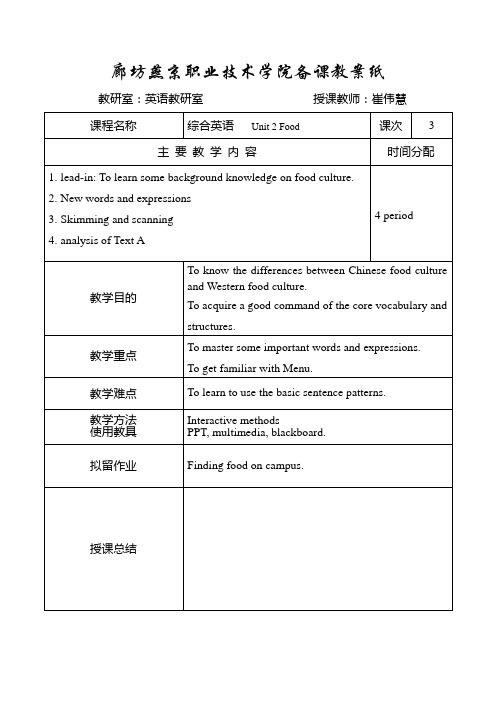
廊坊燕京职业技术学院备课教案纸教研室:英语教研室授课教师:崔伟慧Period 1~2Part AStep 1:lead-in (10minutes)1. What have you seen in the picture (P24)? (Food)2. What are they? (…)Today we will move on to Unit 2. The topic is “Food”.3. For most of the Chinese people, what do we usually eat for breakfast? (Some wheaten-food, porridge, soya-bean milk…)4.If I ask a foreigner the same question, the answer may be different, right?5. What do westerner usually eat for their breakfast?(bread, hamburgers, hotdogs, coffee, milk…)4. Are Chinese food and western food the same? (No)5.Why Chinese people and westerner eat differently?(different food culture)Show Ss some pictures. Lead Ss to talk about fast foods in MC Don ald’s and KFC. Fast food has the same feature, which is high calorie and low nutrition-----junk food.Chinese people stress balance and health. What is a balanced and healthy diet? (cereals, vegetables, protein, meat, milk, fruits…)Step 2: New words and expressions (10 minutes)Ask students to read the new vocabulary of text A. Give students 2minutes to get familiar with the new words and expressions.Chinese meaning----English wordStep 3: task 3. (divide the students into 10 groups)Step 3 Skimming and scanning (20 minutes)A: Group workDivide students into several groups. Give students 10 minutes to read the passage quickly and answer the questions on page 29.B: identify key words for the following paragraphs.Paragraph 2: common ____ in diet.Paragraph 3: many students will____ to lose weight.Paragraph 4: there are many____ that college students have these bad eating habits.Step 4: summarize the main content of text A. (5 minutes)Text A mainly introduces the damages of junk food, and analyzes the reasons why students eat junk food, and how to have a healthy and balanced diet.Step 4: analysis of Text AHelp the students have a deep understanding of the text by explaining the language points. If time permits, have the students practice using them by composing new sentences.1.on one’s owne.g. We cannot solve this problem on our own.2. end upe.g. At first they hated each other, but they ended up getting married.3. contribute toe.g.This book contributes little to our understanding of the subject.4. go on a diete.g. Mary went on a diet last week as suggested by her doctor.5. intakee.g. Lower your intake of fat and alcohol to improve your health.…Step 5: HomeworkExercises related to Text A.Period 3~4Part BStep 1: Check the answers of exercises for Text A. review new words and expressions learned in Text A.Step2: Lead-in1.Listen to the recoding of Task 1 and complete the passage.2.Ask one student to retell the main content of the passage.3.Ask students to discuss the questions in small groups about eating inthe college canteen. Questions: 1) How do you like the food in your college canteen? (Cues: taste good/bad/heavy/light…)2) What is it like when you eat in the canteen? (Cues: eating quietly,talk with others, noisy…)Step 3: Fast readingGive students 15 minutes to read Text B and finish exercises of Task 1 and Task 2.Part CStep 1: learn central vowels and back vowels1.The teacher reviews the pronunciation of front vowels with students.2.The teacher shows students how to pronounce central and backvowels.3.Play the recording and ask students to circle the word they hear.4.Listen and practice the sentences content front vowels.5.Listen and read after sentences in Task 3.Step 2: grammar1.The teacher explains the important points in the table.2.Ask students to do exercises of Task 1 and Task 2.Step 3: writing1.Introduce some writing strategies on effective sentences to students.2.Do exercises of Task 1 and Task 2.3.Ask one student to read the sample on page 44.Step 4: HomeworkSuppose you are working part-time in the school cafeteria. Create a menuwhich includes vegetables, pork, fish, beef, soup, rice/nodules, and drinks.。
21世纪大学实用英语教案第二册 Unit3
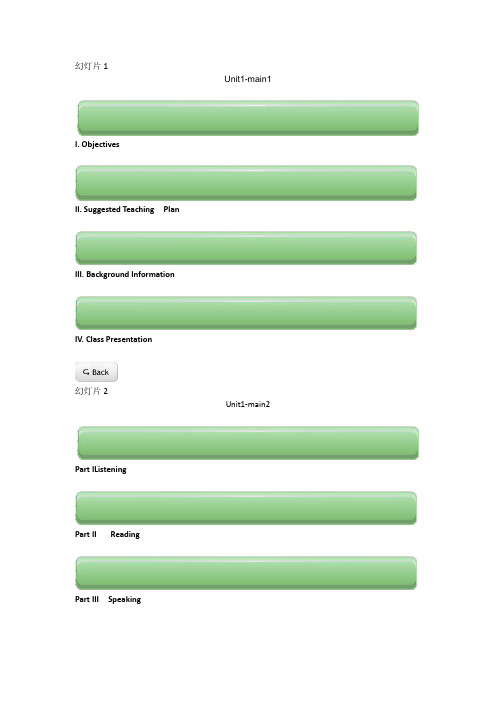
幻灯片1Unit1-main1I. ObjectivesII. Suggested Teaching PlanIII. Background InformationIV. Class Presentation幻灯片2Unit1-main2Part IListeningPart II ReadingPart III SpeakingPart IV Translation & WritingPart V Time to RelaxVideo Exercises幻灯片3ObjectivesI. ObjectivesAfter studying this unit, the students are expected to1. have listening and speaking practices to learn how tolive up to their potential and acquire the theme-related expressions and their functional structures;2. understand the main idea of Text A and Text B, masterthe useful sentence structures, words and expressionsfound in the relevant exercises of the texts;3. know how to use parallel structures to add balance,rhythm and clarity to the sentences;幻灯片4ObjectivesI. Objectives4. be able to read a passage about how to advertise on a website;5. be able to write a letter of accepting/declining an offer.幻灯片5II. Suggested Teaching Plan for Unit 1TimeContents Plan1 period Theme-relatedListening Sections 1 & 2To start the new unit, the teacherA. plays the short talk once before handling UsefulLanguage in a unique way, ., asking studentsto read them loud in class;B. plays the short talk once more, or twice moreifnecessary, and asks class to complete thesummary as required; C. has a brief discussion with the students on thesummary of the short talk;D. plays the talk again with an emphasis on detailsso that students can fill in the blanks of the text. Sections 3 4 & 5A. keeps the theme in mind while making atransition from the short talk to the two dialogues;幻灯片6Objectives3B. handles Useful Language in a unique way,., asking students to come up with theirown equivalents to replace the items in the box;C. plays the first dialogue once, or twice ifnecessary, and asks students to do the T/Fexercise as required to explore the main idea;D. plays the first dialogue once more for thedetails so that students will have no troubleanswering the questions;E. plays the second dialogue once, or twice ifnecessary, and then asks students to do thelistening comprehension exercises;F. checks the answers in a meaningful way,., putting the key word effort on thechalkboard, encouraging the students toaround it with the relevant information fromthe dialogue.Theme-relatedListening幻灯片7Time Contents PlanObjectives3Review ofTheme-relatedListeningSections3 periodsReviewThe teacherA. has a brief review of what students havelearned in the first period of listeningpractice;B. makes a meaningful transition to Text A.StarterAfter finishing the listening tasks, the teacher turns to Text A of the unit. To begin, the teacher Text A &Text-relatedExercisesA. lets the students figure out what the title of Text A can mean. This can be done in complete English sentences or just phrases. If the students have difficultyTime Contents Plan幻灯片8Objectives4Timedoing this, the teacher can ask them to think of a situation where impossibility becomes a fact. The teacher can provide them with the following key words in English: happen, years ago, absolutely impossible, think of, give up, make sincere efforts, find a clue, turn out, solve the problem.B. gives the students 10 minutes to read TextA and find out the cause of the problem for thecar in the story and asks them to tell whatlessons can be drawn from the story.幻灯片9Time Contents Plan Contents PlanThe teacherA. discusses the whole text with the students;B. guides the students through the exercises,focusing on certain items or leaving someexercises as the students’homeworkaccording to the students’levels.The teacherA. asks the students to go over the text and do the multiple choice questions about it;B. while discussing the text with the students, calls the students’attention to the use of parallel structures and their functions;C. lets the students do the vocabulary and language use exercises either in class or after class.periodsText B &Text-relatedExercises幻灯片10Objectives5periodPracticalReadingThe teacherA. explains the passage about how to advertiseon “Paperboy;”B. gives the students 5 to 10 minutes to do theexercise.1 periodSpeakingThe teacherA. fully understands what the exercises are intended to do;B. in Ex. 1 initiates a discussion on each statement of the list to ensure a better understanding on the part of students, and then help students know what two categories are before they do the exercises as required;幻灯片11Objectives6Time Contents PlanC. asks class to read loud the dialogue in Ex. 1 before doing the role-play either with the script used by turns or with it completely free;D. in Ex. 2 has a brief review of the core theme of Text A to elicit the important statement: I am possible, and then asks one student to read loud the example monologue before encouraging some students to carry out the task.Translation and Writing,Time toRelax &Workbook1 periodThe teacherA. leaves the sentence translation exercise as the students’homework;幻灯片12Time Contents PlanTime Contents Planfirst exercise in Practical Writing, and then requires them to do the next two exercises after class;C. plays the record of the story “Blue Suit”in class and lets the students work out what makes the problem- solving humorous (This can be done as students’homework if there isn’t much time left in class);D. if possible, plays the video in theWorkbook in class and lets the students dothe exercise based on the video.幻灯片13III. Background Information1General Motors 通用汽车General Motors is an American multinational automaker based in Detroit, Michigan and the world’s second largest automaker. Founded in on Sept. 16, 1908, GM now employs 209,000 people in every major region of the world and does business in some 157 countries. General Motors produces cars and trucks in 31 countries, and sells andservices these vehicles through the following divisions: Buick, Cadillac, Chevrolet, GMC, Opel, Vauxhall, and Holden. GM’s OnStar subsidiary(子公司) provides vehicle safety, security and information services.幻灯片14III. Background Information1Pontiac 庞蒂亚克Pontiac was an automobile brand that was established in 1926 as a companion make for General Motors’Oakland. Pontiac was sold in the United States, Canada, and Mexico by General Motors (GM). Pontiac was relatively more popular in Canada, where for much of its history it was marketed as a low-priced vehicle.On April 27, 2009, amid ongoing financial problems and restructuring efforts, GM announced it would discontinue the Pontiac brand by the end of 2010 and focus on four core brands in North America: Chevrolet, Cadillac, Buick, and GMC. The last Pontiacs were built in late 2009, with the final dealer franchises expiring October 31, 2010.幻灯片15III. Background Information1Dessert 甜点In Western culture, dessert is a course that typically comes at the end of a meal, usually consisting of sweet food. The word comes from the French language as dessert, “to clear the table”and “to serve.”Common desserts include cakes, cookies, pastries, ice cream, pie, and candies. Fruit may also be eaten with the dessert.The word dessert is most commonly used for this course in ., Canada, Australia, New Zealand and Ireland, while sweet and pudding may be alternative terms used in the UK and some other Commonwealth countries, including India. In England, the term pudding is usually used among the upper and upper-middle classes, with dessert only used if the course consists of fruit or sweetmeats, after the cheese and biscuits course.幻灯片16Part IListeningPart IListeningListentotheupcomingshorttalkandfillintheblanksinthesummarybelowwithtwoorthreewords.Get tingtoknowthefollowingusefullanguagefirstmightbehelpful.1Useful Languageabbreviation // n. 缩写intend // vt. 意欲critically // ad. 批判地tough // a. 艰难的seemingly // ad. 看来似乎challenge // n. 挑战solution // n. 解决方法hows and whys 缘由,道理幻灯片17ScriptPBL is intended to train students to be 1) . To be a problem solver is to learn how to raise a question,how to use information, how to 2) , and how to make a decision. Of course, it is not easy to a problem solver.But it is no good to say something is impossible without 3), even though it can seem so at first. Only when you give yourself completely 4) is nothing impossible.problem solvers________________think critically_____________making an effort________________to the possible_______________幻灯片18Script:Hello class,Does PBL ring a bell It is an abbreviation for problem-based learning, an education model that intends to train students to become problem solvers. This means that students learn how to think critically, how to raise important questions, how to use the information gained, and how to make decisions when solving a particular problem. Do you think this is what is supposed to be happening at college Or is the goal to stay passive receiving knowledge from the instructor all the time幻灯片19Of course, it is not easy to be a problem solver. A particular problem can be difficult and tough, at first seemingly impossible to solve. Yet let’s not forget that the toughest challenge can also offer the greatest opportunity. So don’t just say something is impossible without making an effort. Give it a try and you might find out you can go much farther than you expected.In short, there’s no way to get to solutions without first exploring the hows and whys of the problem. What happens happens for a reason. Only when you are open to the possible is nothing impossible.幻灯片20Objectives22Listen to the short talk again and fill in the blanks below with the missing words. 2Hello class,Does PBL ring a bell It is an abbreviation for 1), an education model that intends to 2)to become problem solvers. This means that students learn how to think critically, how to raise important questions, how to use the information gained, and how to make decisions when solving 3) . Do you think this is what is supposed to be happening 4) Or is the goal to 5)receiving knowledge from the instructor all the timeproblem-based learning________________________train students______________a particular problem___________________at collegestay passive_______________________幻灯片21Objectives23Of course, it is not easy to be a problem solver. A particular problem can be 6), at first seemingly impossible to solve. Yet let’s not forget that the toughest challenge can also offer 7) . So don’t just say something is impossible without 8). Give it a try and you might find out 9)much farther than you expected.In short, there’s no way to get to solutions without first exploring the 10)of the problem. What happens happens 11). Only when you are open to the possible is 12) . difficult and tough_________________the greatest opportunity_______________________making an effort_________________you can go___________hows and whys________________for a reason_____________nothing impossible___________________幻灯片22Objectives24MartinandLisaaretalkingaboutpossibilityand impossibility.Listentotheirconversationand thendecidewhether theconversation-basedstatementsbelowaretrue(T)orfalse(F).Gettingtoknowthefollowingusefullanguagefirstmightbehe lpful.3Useful Languagenegative // a.stuck // a.belief // n.The point is simply that…Couldn’t have said it better.billboard // n.You betcha!否定的;消极的被困住信念其要点是……说得太好了。
前景实用英语 教案 Unit 3 Learning
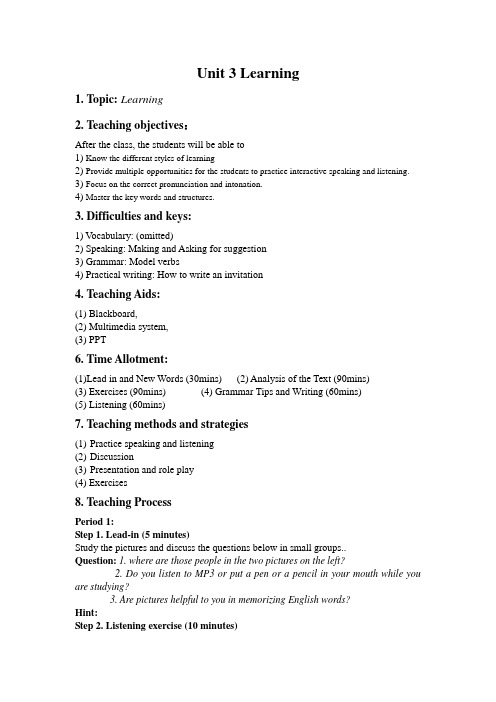
Unit 3 Learning1. Topic: Learning2. Teaching objectives:After the class, the students will be able to1) Know the different styles of learning2) Provide multiple opportunities for the students to practice interactive speaking and listening.3) Focus on the correct pronunciation and intonation.4) Master the key words and structures.3. Difficulties and keys:1) V ocabulary: (omitted)2) Speaking: Making and Asking for suggestion3) Grammar: Model verbs4) Practical writing: How to write an invitation4. Teaching Aids:(1) Blackboard,(2) Multimedia system,(3) PPT6. Time Allotment:(1)Lead in and New Words (30mins) (2) Analysis of the Text (90mins)(3) Exercises (90mins) (4) Grammar Tips and Writing (60mins)(5) Listening (60mins)7. Teaching methods and strategies(1)Practice speaking and listening(2)Discussion(3)Presentation and role play(4) Exercises8. Teaching ProcessPeriod 1:Step 1. Lead-in (5 minutes)Study the pictures and discuss the questions below in small groups..Question:1. where are those people in the two pictures on the left?2. Do you listen to MP3 or put a pen or a pencil in your mouth while you are studying?3. Are pictures helpful to you in memorizing English words?Hint:Step 2. Listening exercise (10 minutes)Step 3. Vocabulary in Text A (20 minutes)Ask Ss to read new words and expressions by themselves and then read the new words together. Explain the important points.1. unique a. being the only one of its kinde.g. Everyone’s fingerprints are unique..2. in general : usually; as a wholee.g. In general, an English dictionary starts with the letter A.3. visual a. of or gained by seeing or sight.e.g. The teaching building makes a tremendous visual impact.Step 4. Vocabulary Check Task 3&4 (10 minutes)Ask the students to finish the exercise, vocabulary check (part B and C). Then check the answers.Period 2:Step 1. Language Points in Text A (30 minutes)Explain the language points to Ss and analyze the structure of the passage. Pay more attention to longer sentences in Text A and try to make Ss understand.Kinaesthetic learners can have…especially past elementary age:Because traditional schools pay less attention to kinaesthetic learners than to auditory and visual learners, kinaesthetic learners can have the most difficulty in their learning, especially when they finish elementary school and grow older.Step 2. Comprehension of Text A (15 minutes)Give students 5 minutes to go through the text, ask them to finish the exercise then check the answers.Period 3:Step 1. Comprehensive Exercises (45 minutes)Ask the students to finish the exercise then check the answers.Period 4:Step 1. Phonetics (20 minutes)Ask the students to pay more attention to the Rising Diphthongs and then do some listening and speaking.Step 2. Grammar Tips 情态动词( Model Verb) (20 minutes)First, ask Ss to preview the explanation and then give further study of the grammar tip. Do the exercises to check out whether Ss know the grammar well.Period 5&6: Practical Writing (How to Write an Invitation)It is necessary to teach some writing skills beforehand, and then study the sample. Ask Ss to write a note on the spot.Step 1. General Introduction (10 minutes)Step 2. Sentence patterns for Invitation (15 minutes):Introduce some useful sentence patterns to help students understand how to write a thanks note.1...would be delighted for you to join them.2...request the honor of your presence…3. …would like to invite you to …Step 3. In-class Activities (20 minutes)This section contains short dialogues that making and asking for suggestions in campus.Step 4. Speaking Out (10 minutes)This part is designed for students using certain expressions to ask for suggestions. Period 7&8:Step 1. Culture Notes (15 minutes)Let the students read this section on their own. The teacher may want to check if they have read this section by asking the following questions:Step 2. After-class Activities (30 minutes)Although the exercises included in this part are meant for the students to practice in their spare time, the teacher may want to select some of them to practice in class, especially those in Sections A and B. Unlike those in Book One, the exercise items included in Section B are mini-dialogues designed to prepare the students for the standardized examination they are to take in the following year.9. Text review and consolidation(5min)(1) Key words of each para.(2) Important Phrases10. Homework Assignment(2min)(1) Words and expression study(2) Finishing the exercises of the text11. Questions from/Discussions with the students(5min)12. Reflection of the class teaching:(1) Have key points every class and dictate in next, and give students press to study.(2) Try to go more opportunities for the poor-level students.。
前景实用英语unit3knowledgeandskills

This picture is about basketball training. The trainer, that is, the person in red, is probably teaching the trainees some skills, and the trainees are listening to him very carefully.
Phonetics
Grammar Writing
Functions and Notions Workshop
Part A Lead in
Task 1 Task 2
Task 3
Part A Lead in
Task 1 Study the pictures and discuss the questions below in small groups. Use the words given below if necessary.
2. How do you understand the words in the second picture? Do you know the Chinese for it?
“Practice makes perfect” means that the more you practice, the better you will become. If you want to improve your skills, you should practice as much as possible. The Chinese meaning of it is “业精于勤” or “勤能补拙” or “熟能生巧”.
新编实用英语综合教程2(第三版)Unit3
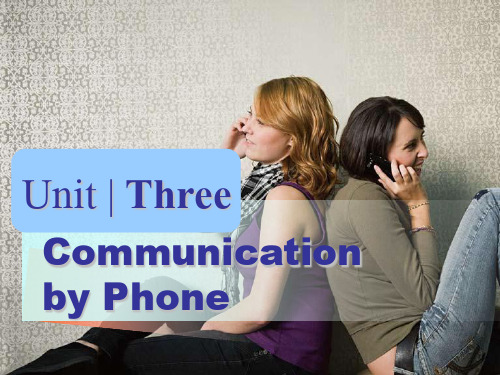
5) Where did Dr. An drive Tom to, the hotel or the school? The hotel.
Back
Unit | Three
Listen and Complete
6 Listen to the dialogue for the last time and fill in the blanks according to what you have heard.
ten-minute, fifteen-minute walk to the school.
Back
Unit | Three
Listen and Answer 5 Listen to the dialogue again and then answer the following questions orally.
Unit | Three
Communication by Phone
Unit | Three
Handling a Dialogue
Listen and Decode
Script
4 Listen to a dialogue and decode the message by finding out the correct choices in the brackets according to what you have heard.
need to mention the mobile phones people play with evห้องสมุดไป่ตู้rywhere. The fixed phones
are easily accessible. Almost every 2 __fa_m__il_y_ has a phone. Some families even
21世纪大学实用英语综合教程 第二册 Unit 3

教案授课单元21世纪大学实用英语综合教程第二册Unit 3本(章)节授课方式课堂讲授(√)实践课()教学时数 6授课要点本(章)节教学目标1,指导学生理解课文内容;了解人物Michael Jordan2,熟悉课文的体裁,结构3,教授学生掌握核心单词和短语的用法;4,话题讨论,深化学生对本单元主题的认识.教学重点和难点1,approach, challenge, reasonable, exact, puzzle等词的用法2,课文解读,3,从形散的课文中提炼课文观点思考题或作业1, Review the key expressions from the previous lesson.复习上次课的重点短语,随机提问。
2, Read Text B of this unit, and deepen your understanding of the theme in this unit. -Share your reflections on this theme in class.3, Review the new words and phrases of this text. Try to use them in your daily life.4, Finish the reading and listening tasks of this unit.教学内容与组织安排1st period Text A (Global Reading)2nd period Text A (Detailed Reading)3rd period Grammar Review4 th period Practical Writing5th period Text B6th period Improve Your Reading Skills1st period Text A (Global Reading)1 Background InformationMichael Jordan was born on February 17, 1963, in Brooklyn, New York, but his family decided to move to Wilmington, North Carolina when he was still a toddler. Jordan is the fourth of five children, including two older brothers and an older and younger sister. Michael’s dad worked hard at an electric plant while his mom labored full-time at a bank. Jordan’s parents worked hard to provide him and his siblings with a comfortable lifestyle.By the time Jordan was finishing his senior year at Laney, he had grown to 6’5” and attained a basketball scholarship from the University of North Carolina. Jordan’s ever-growing popularity began at UNC where he made a last minute game winning shot in the NCAA championship game.Michael’s talent and personality transcended the very lives of his fans. He single-handedly paved the way for off-the-court athlete endorsements —a billion dollar industry today!2, Group Discussion1) What’s Michael Jordan’s ultimate goal?2) How did he approach his goals?3) What did Jordan learn when he got cut from the varsity team in high school?4) How did Jordan achieve his goal of becoming a starter on the varsity?5) What did Jordan visualize each time?6) What did Jordan gain every time he reached his goal?7) What does the writer think of success?3, OverviewNothing seek, nothing find (无所求则无所获), as the saying goes. Set a goal, try to approach it, and there’s a good chance you’ll be successful. Talk to your classmates and tell them what your personal and professional goals are and how you achieved / will achieve them.If you try as hard as you can and don’t succeed, don’t get down on yourself. Actually you will have some accomplishments along the way. Besides, not everyone is going to be the greatest at something. But you still can be considered a success.4, Understanding the TextWhat did he visualize each time?What did he gain every time he reached his goal?What does the writer think of success?Why does he always set short-time goals?What’s the best way of accomplishing something?2nd period Text A (Detailed Reading)Ⅰ. Words and Expressionsprofessional a. of or belonging to a profession; earning money by playing a game, acting, etc.职业的;属于某专业的;职业性的approach 1. vt. move towards; come or go near(er) to; (begin to) deal with靠近;接近;(着手)处理;(开始)对付,对待2. n. act of approaching; way leading to sth.; path; road; way of dealing with a person or thing 接近;途径;入门; (处理问题的)方式,方法challenge n. invitation or call (to sb.) to take part in a game, contest, fight, etc. to prove who is better, stronger, more able, etc.; difficult, demanding or stimulating task 挑战;邀请比赛;艰巨的任务She refused to take up the challenge that was offered.Bringing up a child is a tough challenge most people will face.step by step: proceeding steadily from one stage to the next; gradually 一步一步地;逐步地He is improving step by step.Step by step he learned the rules of the game.level n. relative position in rank, class or authority 水平,级别catch up with advanced world levels 赶上世界先进水平Students at this level tend to have a lot of problems with grammar.这一级别的学生往往会有许多语法问题。
